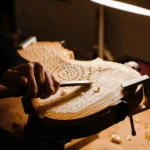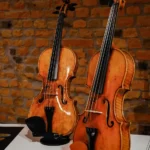Acoustic Violin to Impress Anyone
Back to BlogThe violin is one of the most loved and appreciated instruments in the world. There is no doubt that the acoustic violin gives you the best and most delightful tunes due to the instrument’s incredible anatomy and format.
To become this impressive instrument as it is today the violin was developed centuries ago by the great minds of the Master makers from the past.
Acoustic violins are beautiful, complex, and delicate instruments. The carefully selected wood, fitted with high-quality strings, combined with the maker’s skills, creates the masterpiece.
The shape of the violin was created centuries ago.
The earliest known existant violin, now in the National Music Museum in Vermillion, was made by Andrea Amati (ca. 1505-1577). During his time, Amati introduced the violin in its mainly present unchanged form. The expertise of these luthiers helped the makers today to build valuable violins with the amazing quality of the sound that the wooden sound box produces.
The combination of the craftsmanship with the wood, varnishing, and everything else in the violin-making create these sound boxes that can be incredibly difficult to replicate.
The violin’s body resonates just like a loudspeaker cone. The shell also produces pressure fluctuations inside the hollow body, a highly localized flow of air bouncing in and out of the f-holes cut in the top plate.
The idea that a “secret” known only to Stradivari and other classic Italian makers accounts for the outstanding sound of their instruments is no longer widely accepted because the instruments we listen to today are very different from when they were originally made.
String vibrations transfer energy to the shell modes by means of the bridge, which rocks asymmetrically.
A violin’s format and anatomy has all to do with its potential
In the head, we have the pegbox, located at the very top of the violin where the strings are attached, along with the Scroll, the curling shape carved into the top of a violin.
The Scroll is purely decorative and has no effect on the instrument’s overall sound, but it is where the luthier can show all his skills and creativity.
Underneath the Scroll is the pegbox, where you’ll find four tuning pegs corresponding to the four strings on your violin.
Then following the next section of the violin, there’s the neck, a slender piece of wood that attaches the body of the violin to the pegbox and Scroll at the top.
At the end of the fingerboard, there is the nut, a small ridge whose function is to control the placement and the height of the strings.
The violin body is the biggest surface area and is made up of three pieces: the front plate or “belly” and the backplate, with these two pieces being connected by the sides or “ribs” of the violin.
Soundholes or the F-holes cut in the belly, as well as a rounded back made of one or two pieces of maple, help to project sound from the inside of the violin, while curved ribs link the body to its back. The hollow interior is responsible for amplifying the sound when the instrument is played.
The edges of the back and belly can be strengthened with inlays of pearwood, ebony, maple, paper, whalebone, willow, etc. Varnishing also has its role, by protecting the instrument from temperatures and the humidity and also giving some influence to the sound.
Violins are being made by luthiers from all over the world and each of them has their own approach.









